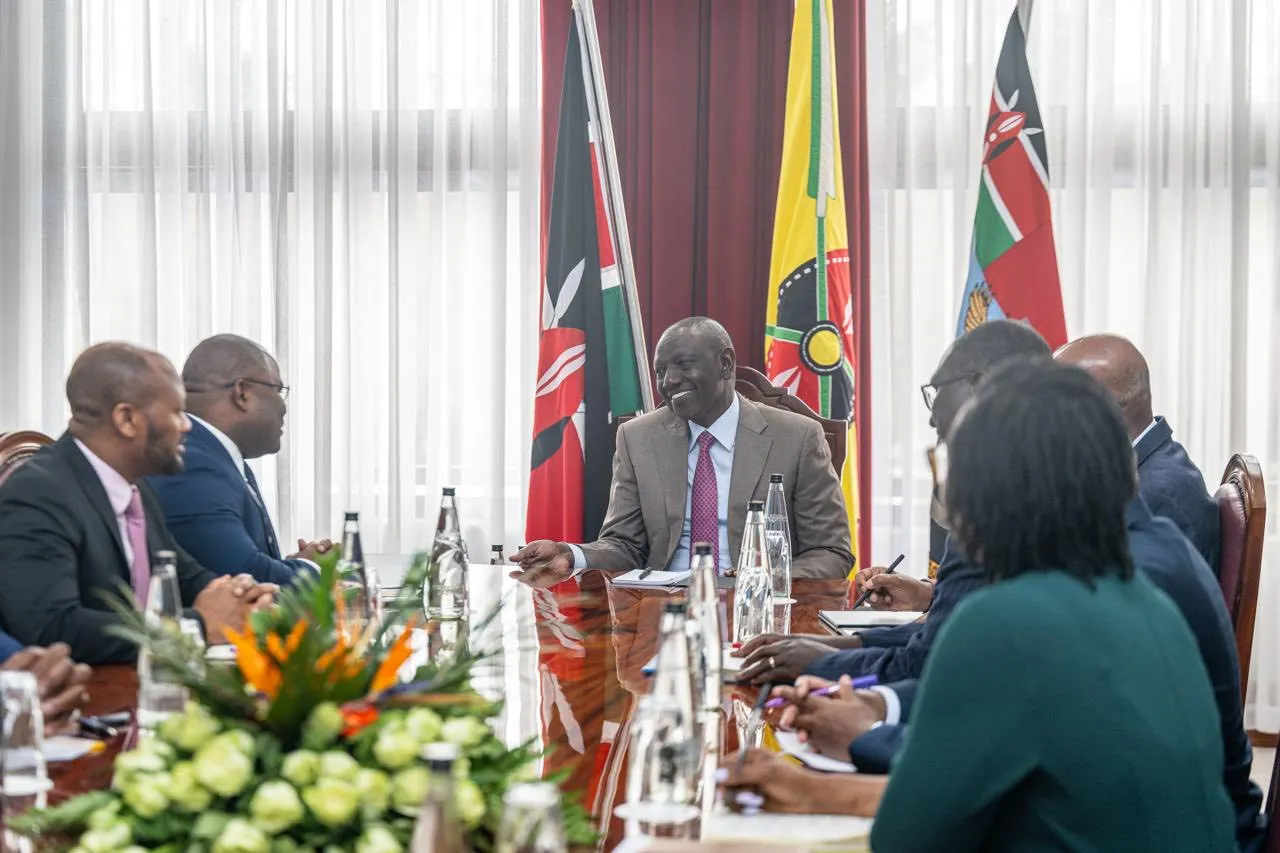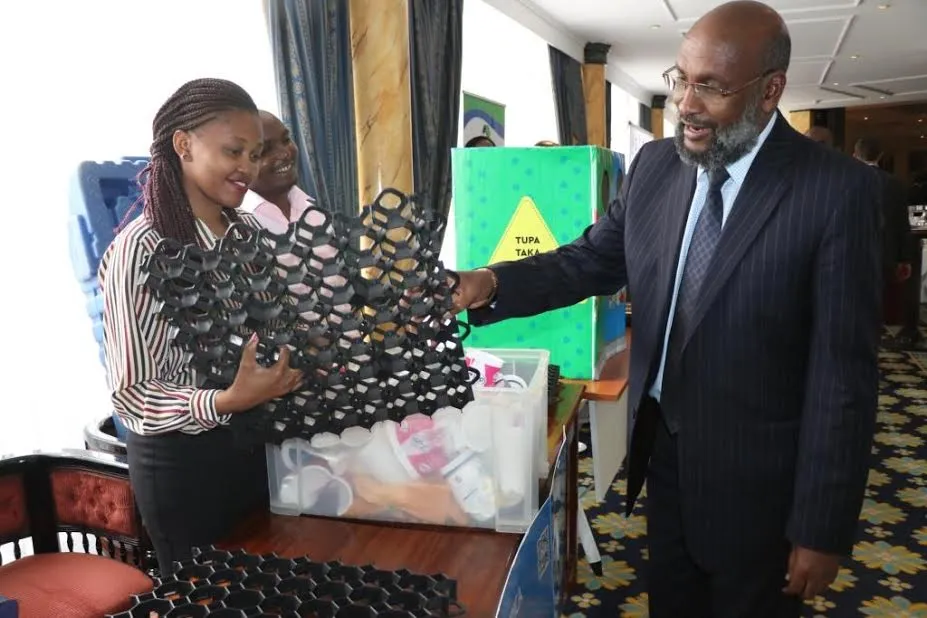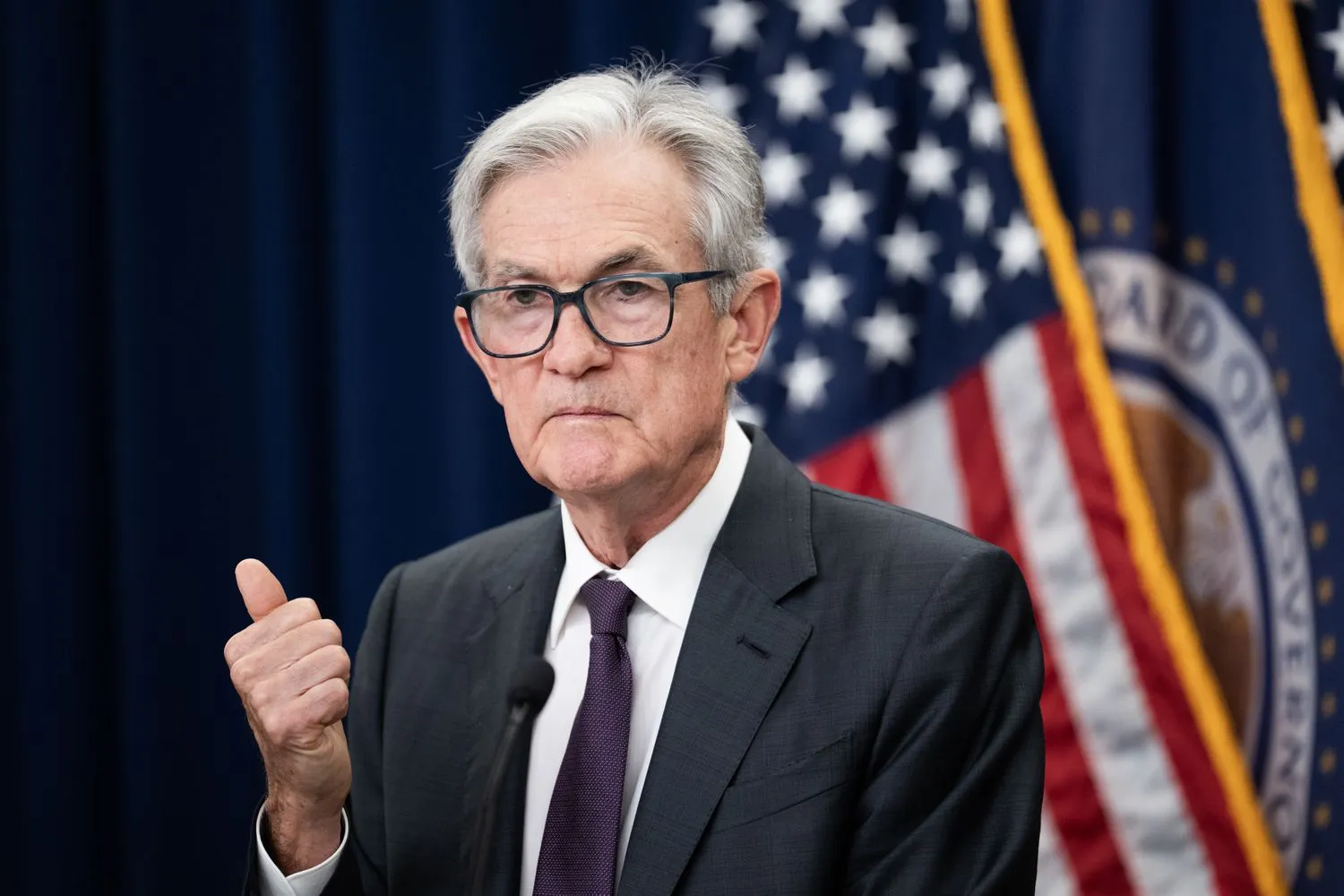President William Ruto has announced that the World Bank has endorsed Kenya’s ambitious plan to establish a National Infrastructure Fund aimed at expanding the country’s road and rail networks, irrigation systems, and energy generation capacity. The announcement came following a meeting with World Bank Africa Executive Director of Africa Group One, Zarau Kibwe, at State House in Nairobi on Tuesday, November 18, 2025.
Speaking during the high-profile meeting, President Ruto highlighted the Bank’s support for the proposal to construct 50 mega dams, which would increase land under irrigation by 2.5 million acres across the country. The President emphasized the critical importance of this infrastructure investment, noting that with 85 percent of Kenya classified as arid and semi-arid land, irrigation represents the nation’s pathway to sustainable food production and agricultural transformation.
“With 85 per cent of Kenya being arid and semi-arid, irrigation is the new frontier for increased food production and productivity. Rain-fed agriculture on the remaining 15 per cent has reached its limits,” President Ruto stated, underscoring the urgent need to shift from Kenya’s traditional dependence on rainfall-based farming to a more reliable irrigation-centered agricultural model.
Build the future you deserve. Get started with our top-tier Online courses: ACCA, HESI A2, ATI TEAS 7, HESI EXIT, NCLEX-RN, NCLEX-PN, and Financial Literacy. Let Serrari Ed guide your path to success. Enroll today.
The National Infrastructure Fund: A Comprehensive Development Strategy
The National Infrastructure Fund represents a transformative approach to financing Kenya’s development ambitions. According to President Ruto’s October announcement, the fund is expected to mobilize resources for the construction of 50 mega dams, 20,000 kilometers of rural roads, dualization of 2,000 kilometers of highways, and generation of an additional 10,000 megawatts of electricity to support manufacturing and industrialization.
The President explained during the commissioning of Phase One Horizontal Infrastructure at Konza Technopolis in Makueni County that the fund will pool resources from multiple sources, including the national budget, private sector investments, and proceeds from privatization initiatives. This innovative financing model aims to reduce Kenya’s reliance on external borrowing while ensuring sufficient capital for large-scale infrastructure projects that have traditionally stalled due to funding constraints.
“Putting together resources from our budget, building resources from the private sector, and resources from the privatisation, we will create a big pool of resources that we can use in an innovative manner just as other countries have done,” President Ruto explained, drawing comparisons with successful infrastructure financing models employed by other developing nations that have achieved rapid economic transformation.
Addressing Kenya’s Food Security Crisis Through Irrigation
The emphasis on irrigation infrastructure comes against the backdrop of Kenya’s mounting food security challenges and unsustainable food import expenditures. President Ruto revealed that Kenya currently spends approximately Ksh500 billion annually on food imports, including maize, wheat, rice, sugar, and edible oils—resources that could be redirected toward domestic agricultural production with proper irrigation infrastructure in place.
The proposed construction of 50 mega dams modeled after the Thwake Dam project represents a fundamental shift in Kenya’s agricultural strategy. The Thwake Dam, located at the confluence of the Athi and Thwake rivers straddling Makueni and Kitui counties, serves as a blueprint for the kind of multipurpose water infrastructure Kenya aims to replicate nationwide. Once completed, Thwake Dam will supply 150,000 cubic meters of treated water daily to over 1.3 million people, support irrigation of 40,000 hectares of farmland, and provide capacity for hydropower generation.
President Ruto has allocated approximately Ksh1.5 trillion for the irrigation component of the National Infrastructure Fund, reflecting the government’s recognition that sustainable food security cannot be achieved through rain-dependent agriculture alone. The President has repeatedly emphasized during public engagements across the country that Kenya has nearly exhausted its potential for rain-fed agriculture, making irrigation the only viable path forward for feeding the nation’s growing population.
During Mashujaa Day celebrations in Kitui County on October 20, 2025, President Ruto articulated this vision clearly: “Rain-fed farming can no longer sustain our growing population or our aspirations. That is why we have now set an ambitious target to build at least 50 mega dams across Kenya and to bring at least 2 million acres under irrigation.”
The Challenge of Kenya’s Arid and Semi-Arid Lands
The urgency of Kenya’s irrigation agenda becomes evident when examining the country’s geographical and climatic realities. Over 80 percent of Kenya’s land mass is classified as arid and semi-arid, receiving annual precipitation of only 200-750 millimeters. These Arid and Semi-Arid Lands (ASALs) account for approximately 30 percent of Kenya’s population—about 16 million people—who earn their living principally through pastoralism and small-scale agriculture under extremely challenging conditions.
The ASALs are particularly susceptible to droughts and flooding, and with increasing impacts from climate change, these areas face risks of desertification. A large percentage of ASALs have been degraded from deforestation and overgrazing, which further reduces land productivity and threatens food security, livelihoods, and biodiversity. Meanwhile, Kenya’s high-potential agricultural areas—representing only about 20 percent of the total land mass—face their own constraints from population pressure and land subdivision.
According to data from the Food and Agriculture Organization, agriculture in Kenya is predominantly rainfed, with irrigated agriculture accounting for only 2.4 percent of cultivated area despite contributing 3 percent to GDP and 18 percent to national agricultural production. This stark disparity underscores the transformative potential of expanding irrigation infrastructure—a relatively small increase in irrigated land could yield disproportionately large gains in agricultural output and food security.
Energy Generation to Power Industrialization
Beyond agriculture, the National Infrastructure Fund will target a massive expansion of Kenya’s electricity generation capacity. President Ruto has outlined plans to increase power generation from the current 2,300 megawatts to 10,000 megawatts within the next five to seven years, at an estimated cost of approximately Ksh1 trillion.
This ambitious energy expansion is viewed as essential for supporting Kenya’s industrialization agenda and attracting manufacturing investments that require reliable, affordable electricity. The President has emphasized that without adequate power generation capacity, Kenya cannot hope to transform from a primarily agricultural economy to a diversified industrial economy capable of creating sufficient employment opportunities for its rapidly growing young population.
The energy component of the National Infrastructure Fund aligns with Kenya’s broader economic transformation goals, including positioning the country as a manufacturing hub within the African Continental Free Trade Area (AfCFTA) framework. President Ruto has noted that Kenya has already secured access to major international markets through the AfCFTA, the European Union under the Economic Partnership Agreement, the United States under the African Growth and Opportunity Act (AGOA), and China through bilateral trade agreements.
However, the President has stressed that market access alone is insufficient—Kenya must have the production capacity to meet demand both domestically and in export markets. “We have the American market. We have the Chinese market that is now open. We have the European market negotiated under the Economic Partnership Agreement. We also have the Africa Continental Free Trade Area market of 1.4 billion people,” President Ruto explained during a recent public address, adding that the challenge is not market access but production capacity constrained by inadequate infrastructure.
Road and Rail Network Expansion
The transportation infrastructure component of the National Infrastructure Fund encompasses an extensive agenda to upgrade Kenya’s road and rail networks. President Ruto announced that the fund aims to raise Ksh4.5 trillion to tarmac 20,000 kilometers of rural roads, construct 10,000 kilometers of additional paved roads, and dualize 2,000 kilometers of highways over the next five to ten years.
The road infrastructure investments target both urban and rural connectivity improvements. In urban areas, the focus is on highway dualization to reduce congestion and improve traffic flow, while rural road investments aim to connect agricultural production areas to markets and essential services. During a recent meeting with grassroots leaders from Kitui, Makueni, and Machakos counties, President Ruto emphasized that improved road networks will enable residents to access healthcare, schools, and market centers more effectively.
The rail component includes completing the Standard Gauge Railway (SGR) extension from Naivasha to Kisumu and Malaba, opening up access to Uganda, Rwanda, Burundi, and the Democratic Republic of Congo. This regional rail connectivity is viewed as critical for positioning Kenya as the logistics hub for East and Central Africa, facilitating trade and economic integration within the region.
One decision can change your entire career. Take that step with our Online courses in ACCA, HESI A2, ATI TEAS 7, HESI EXIT, NCLEX-RN, NCLEX-PN, and Financial Literacy. Join Serrari Ed and start building your brighter future today.
World Bank Support and Project Implementation
The World Bank’s endorsement of the National Infrastructure Fund builds on decades of collaboration between Kenya and the international financial institution on infrastructure development. The Bank has historically provided both financial resources and technical expertise to support Kenya’s public-private partnership programs, regulatory frameworks, and project preparation activities.
According to recent reports, the World Bank approved Project Preparation Advances worth Ksh1.16 billion to support three major projects: the Kenya Urban Mobility Improvement Project, the Road and Rural Economic Development Project, and the Lake Victoria Basin Development Project. These projects are expected to improve infrastructure, boost trade, and enhance access to essential services in both urban and rural areas.
The Kenyan government received Ksh778 million from the World Bank on November 18, 2025, specifically to finance critical infrastructure developments within the Ministry of Transport. Under the Lake Victoria Basin Development Project, the Kenya National Highways Authority intends to allocate funds to procure goods and hire consulting services for road construction projects in counties including Busia, Homa Bay, Kakamega, Kericho, Kisii, Kisumu, Migori, Nandi, Nyamira, Siaya, Trans Nzoia, and Vihiga.
National Treasury Cabinet Secretary John Mbadi, during a meeting with World Bank Managing Director for Operations Anne Bjerde, emphasized the government’s commitment to implementing the Bottom-Up Economic Transformation Agenda (BETA), which focuses on creating jobs, improving livelihoods, and promoting inclusive growth. Mbadi commended the World Bank for its continued support and reiterated Kenya’s commitment to pursuing prudent fiscal policies to reduce debt risks while protecting key social programs.
Financing Strategy and Private Sector Participation
The National Infrastructure Fund represents a strategic pivot in Kenya’s approach to development financing. Rather than relying exclusively on external borrowing, which has contributed to Kenya’s debt-to-GDP ratio rising from 39 percent in 2010 to 72 percent in 2025, the government is exploring innovative mechanisms to mobilize domestic and private capital for infrastructure investments.
In October 2025, President Ruto announced the establishment of twin funds—an Infrastructure Fund and a Sovereign Wealth Fund—aimed at securing Kenya’s long-term economic stability and promoting prudent investment of public resources. Speaking in Vihiga County, the President explained that these funds will play a key role in promoting sustainable development by channeling resources into long-term national priorities and shielding the economy from external shocks.
The Infrastructure Fund is expected to be capitalized through several sources. First, the government plans to allocate resources from the national budget specifically for infrastructure development. Second, the fund will seek to attract private sector investments, particularly from domestic institutional investors such as pension funds and insurance companies. Third, proceeds from the privatization of select state-owned enterprises will contribute to the fund’s capitalization.
According to analysis by The African Wall Street, the government intends to seed the Infrastructure Fund initially through the sale of shares in the Kenya Pipeline Company and potentially other state assets. This asset monetization strategy aims to provide immediate capital for the fund while reducing the government’s direct operational role in commercial enterprises, allowing it to focus on regulatory and policy functions.
The proposed Infrastructure Fund will need to develop diversified investment strategies and robust governance frameworks to ensure effectiveness and build investor confidence. Experts have emphasized that transparent management, professional oversight, and clear performance metrics will be essential for the fund’s success in attracting both domestic and international capital.
Addressing Infrastructure Financing Gaps
Kenya faces a substantial infrastructure financing gap that the National Infrastructure Fund aims to address. The World Bank has estimated Kenya’s yearly infrastructure financing gap at approximately $2.1 billion for more than a decade. However, the value of private investments into public-private partnership infrastructure projects in Kenya has recently been on a downward trend, with PPP financing declining 91 percent from $353 million in 2023 to $33 million in 2024.
This sharp decline can be largely attributed to the cancellation of major infrastructure contracts, including airport and energy transmission PPP agreements, due to integrity concerns. The reduction in external financing and private sector participation has placed additional pressure on the government to develop alternative financing mechanisms, making the National Infrastructure Fund even more critical to Kenya’s development agenda.
President Ruto has acknowledged these challenges and emphasized the need for innovative approaches to infrastructure financing. “For long, we have been building roads which end up stalling due to lack of funds. For Kenya to grow, we must do things differently,” the President stated during a recent church service in Meru County.
Regional and International Context
Kenya’s infrastructure development agenda unfolds within a broader regional and international context characterized by competing priorities and limited concessional financing. Many African countries face similar infrastructure deficits and are exploring innovative financing mechanisms to address development needs while managing debt sustainability concerns.
The World Bank’s support for Kenya’s National Infrastructure Fund aligns with the institution’s global emphasis on enabling private sector participation in infrastructure investments through its Maximizing Finance for Development (MFD) approach. This approach, adopted by the World Bank Group and guided by the Hamburg Principles endorsed by the G20 in 2017, focuses on working with governments to crowd in private sector capital while optimizing the use of scarce public resources.
President Ruto has drawn comparisons with South Korea’s development trajectory to illustrate the transformative potential of focused infrastructure investment. “Kenya and South Korea had the same GDP when Kenya became independent in 1963. But today, South Korea’s GDP is 20 times bigger than Kenya’s,” the President noted, suggesting that Kenya can achieve similar transformation through disciplined implementation of its infrastructure agenda.
The President has also secured support from other international partners for Kenya’s infrastructure initiatives. In November 2025, President Ruto met with Qatar’s Emir Sheikh Tamim bin Hamad Al Thani in Doha, where Qatar pledged to increase investment in Kenya’s agriculture, infrastructure, and finance sectors, with particular focus on the mega-dam program.
Implementation Challenges and Timeline
While the National Infrastructure Fund represents an ambitious vision for Kenya’s development, implementation will face significant challenges. The government must navigate complex issues including land acquisition for infrastructure projects, environmental assessments and approvals, procurement processes, and coordination among multiple government agencies and stakeholders.
President Ruto has indicated that he will engage Members of Parliament to support the creation of the fund through appropriate legislation. During a recent State of the Nation Address planning meeting, the President stated: “I will be in Parliament next week for the State of Nation Address and I will explain to MPs the need for the fund to finance transformative projects.”
The timeline for implementing the various components of the National Infrastructure Fund extends over five to ten years, reflecting the scale and complexity of the planned investments. The 50 mega dams, 20,000 kilometers of rural roads, highway dualization projects, and power generation expansion represent multi-year efforts requiring sustained political commitment, technical expertise, and financial resources.
Regional development will be prioritized strategically. In Meru County, for example, President Ruto announced that the town will be elevated to city status, making it Kenya’s sixth city, alongside allocation of Ksh7 billion to redesign the Nithi Bridge. In the Ukambani region comprising Kitui, Machakos, and Makueni counties, the government is investing more than Ksh110 billion to build affordable housing units, modern markets, student hostels, and infrastructure improvements.
Economic Impact and Job Creation
The National Infrastructure Fund is expected to generate substantial economic impacts beyond the direct infrastructure improvements. President Ruto has emphasized that the dam construction, road building, and energy generation projects will create millions of jobs, particularly for young people who currently face limited employment opportunities in Kenya’s constrained economy.
The irrigation expansion alone is projected to transform livelihoods for millions of Kenyans currently dependent on subsistence agriculture in arid and semi-arid regions. By bringing 2.5 million acres under irrigation, the projects will enable year-round agricultural production, reduce vulnerability to climate variability, and create opportunities for commercial farming and agro-processing industries.
The expanded road network will improve market access for rural farmers, reducing post-harvest losses and enabling agricultural commercialization. Better connectivity will also improve access to essential services including healthcare and education, contributing to improved human development outcomes in currently underserved rural areas.
The energy generation expansion will support industrialization by providing reliable, affordable electricity for manufacturing enterprises. President Ruto has noted that inadequate power supply has been a major constraint on Kenya’s manufacturing sector, limiting the country’s ability to attract industrial investments and create formal sector employment.
Conclusion: A Vision for Transformation
The World Bank’s endorsement of Kenya’s National Infrastructure Fund represents international validation of the country’s ambitious development agenda. The proposed investments in irrigation, roads, and energy infrastructure aim to address fundamental constraints that have limited Kenya’s economic transformation for decades.
President Ruto has positioned these infrastructure investments as essential for achieving Kenya’s vision of becoming a first-world economy within a generation. The success of this ambitious agenda will depend on effective implementation, transparent governance, sustained political commitment, and the ability to mobilize sufficient financial resources from public, private, and international sources.
As Kenya moves forward with establishing the National Infrastructure Fund and implementing its various components, the country will be watched closely by other African nations grappling with similar infrastructure deficits and development financing challenges. The Kenyan experience may offer valuable lessons—both successes and challenges—for innovative approaches to infrastructure financing in resource-constrained environments.
For the 85 percent of Kenyans living in arid and semi-arid lands, the promise of irrigation infrastructure offers hope for more stable livelihoods and improved food security. For urban dwellers, improved roads and reliable electricity promise better connectivity and economic opportunities. And for Kenya as a whole, the National Infrastructure Fund represents a bold bet that strategic infrastructure investments can catalyze the economic transformation that has remained elusive despite decades of development efforts.
Ready to take your career to the next level? Join our Online courses: ACCA, HESI A2, ATI TEAS 7 , HESI EXIT , NCLEX – RN and NCLEX – PN, Financial Literacy!🌟 Dive into a world of opportunities and empower yourself for success. Explore more at Serrari Ed and start your exciting journey today! ✨
Track GDP, Inflation and Central Bank rates for top African markets with Serrari’s comparator tool.
See today’s Treasury bonds and Money market funds movement across financial service providers in Kenya, using Serrari’s comparator tools.
photo source: Google
By: Montel Kamau
Serrari Financial Analyst
19th November, 2025
Article, Financial and News Disclaimer
The Value of a Financial Advisor
While this article offers valuable insights, it is essential to recognize that personal finance can be highly complex and unique to each individual. A financial advisor provides professional expertise and personalized guidance to help you make well-informed decisions tailored to your specific circumstances and goals.
Beyond offering knowledge, a financial advisor serves as a trusted partner to help you stay disciplined, avoid common pitfalls, and remain focused on your long-term objectives. Their perspective and experience can complement your own efforts, enhancing your financial well-being and ensuring a more confident approach to managing your finances.
Disclaimer: This article is for informational purposes only and does not constitute financial advice. Readers are encouraged to consult a licensed financial advisor to obtain guidance specific to their financial situation.
Article and News Disclaimer
The information provided on www.serrarigroup.com is for general informational purposes only. While we strive to keep the information up to date and accurate, we make no representations or warranties of any kind, express or implied, about the completeness, accuracy, reliability, suitability, or availability with respect to the website or the information, products, services, or related graphics contained on the website for any purpose. Any reliance you place on such information is therefore strictly at your own risk.
www.serrarigroup.com is not responsible for any errors or omissions, or for the results obtained from the use of this information. All information on the website is provided on an as-is basis, with no guarantee of completeness, accuracy, timeliness, or of the results obtained from the use of this information, and without warranty of any kind, express or implied, including but not limited to warranties of performance, merchantability, and fitness for a particular purpose.
In no event will www.serrarigroup.com be liable to you or anyone else for any decision made or action taken in reliance on the information provided on the website or for any consequential, special, or similar damages, even if advised of the possibility of such damages.
The articles, news, and information presented on www.serrarigroup.com reflect the opinions of the respective authors and contributors and do not necessarily represent the views of the website or its management. Any views or opinions expressed are solely those of the individual authors and do not represent the website's views or opinions as a whole.
The content on www.serrarigroup.com may include links to external websites, which are provided for convenience and informational purposes only. We have no control over the nature, content, and availability of those sites. The inclusion of any links does not necessarily imply a recommendation or endorsement of the views expressed within them.
Every effort is made to keep the website up and running smoothly. However, www.serrarigroup.com takes no responsibility for, and will not be liable for, the website being temporarily unavailable due to technical issues beyond our control.
Please note that laws, regulations, and information can change rapidly, and we advise you to conduct further research and seek professional advice when necessary.
By using www.serrarigroup.com, you agree to this disclaimer and its terms. If you do not agree with this disclaimer, please do not use the website.
www.serrarigroup.com, reserves the right to update, modify, or remove any part of this disclaimer without prior notice. It is your responsibility to review this disclaimer periodically for changes.
Serrari Group 2025












